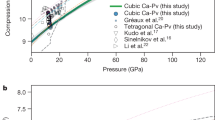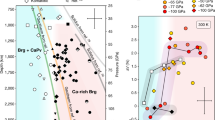Abstract
Cubic CaSiO3 perovskite is a major phase in subducted oceanic crust, where it forms at a depth of about 550 kilometres from majoritic garnet1,2,28. However, its rheological properties at temperatures and pressures typical of the lower mantle are poorly known. Here we measured the plastic strength of cubic CaSiO3 perovskite at pressure and temperature conditions typical for a subducting slab up to a depth of about 1,200 kilometres. In contrast to tetragonal CaSiO3, previously investigated at room temperature3,4, we find that cubic CaSiO3 perovskite is a comparably weak phase at the temperatures of the lower mantle. We find that its strength and viscosity are substantially lower than that of bridgmanite and ferropericlase, possibly making cubic CaSiO3 perovskite the weakest lower-mantle phase. Our findings suggest that cubic CaSiO3 perovskite governs the dynamics of subducting slabs. Weak CaSiO3 perovskite further provides a mechanism to separate subducted oceanic crust from the underlying mantle. Depending on the depth of the separation, basaltic crust could accumulate at the boundary between the upper and lower mantle, where cubic CaSiO3 perovskite may contribute to the seismically observed regions of low shear-wave velocities in the uppermost lower mantle5,6, or sink to the core–mantle boundary and explain the seismic anomalies associated with large low-shear-velocity provinces beneath Africa and the Pacific7,8,9.
This is a preview of subscription content, access via your institution
Access options
Access Nature and 54 other Nature Portfolio journals
Get Nature+, our best-value online-access subscription
$29.99 / 30 days
cancel any time
Subscribe to this journal
Receive 51 print issues and online access
$199.00 per year
only $3.90 per issue
Buy this article
- Purchase on Springer Link
- Instant access to full article PDF
Prices may be subject to local taxes which are calculated during checkout



Similar content being viewed by others
Data availability
Raw data were generated at the Deutsches Elektronen-Synchrotron (DESY) and are available at https://doi.org/10.6084/m9.figshare.17287361. All derived data supporting the findings of this study are available within the article and the Extended Data. Source data for Figs. 2, 3 and Extended Data Fig. 2 are provided with the paper.
References
Irifune, T. & Tsuchiya, T. Mineralogy of the Earth – phase transitions and mineralogy of the lower mantle. In Treatise on Geophysics. Volume 2: Mineral Physics 1st edn (ed. Schubert, G.) 33–62 (Elsevier, 2007).
Hirose, K., Sinmyo, R. & Hernlund, J. Perovskite in Earth’s deep interior. Science 358, 734–738 (2017).
Miyagi, L. et al. Diamond anvil cell deformation of CaSiO3 perovskite up to 49 GPa. Phys. Earth Planet. Inter. 174, 159–164 (2009).
Shieh, S. R., Duffy, T. S. & Shen, G. Elasticity and strength of calcium silicate perovskite at lower mantle pressures. Phys. Earth Planet. Inter. 143–144, 93–105 (2004).
Ballmer, M. D., Schmerr, N. C., Nakagawa, T. & Ritsema, J. Compositional mantle layering revealed by slab stagnation at ~1000-km depth. Sci. Adv. 1, e1500815 (2015).
Gréaux, S. et al. Sound velocity of CaSiO3 perovskite suggests the presence of basaltic crust in the Earth’s lower mantle. Nature 565, 218–221 (2019).
Thomson, A. R. et al. Calcium silicate perovskite’s acoustic velocities can explain LLSVPs in Earth’s lower mantle. Nature 572, 643–647 (2019).
Jones, T. D., Maguire, R. R., van Keken, P. E., Ritsema, J. & Koelemeijer, P. Subducted oceanic crust as the origin of seismically slow lower-mantle structures. Prog. Earth Planet. Sci. 7, 17 (2020).
Garnero, E. J., McNamara, A. K. & Shim, S.-H. Continent-sized anomalous zones with low seismic velocity at the base of Earth’s mantle. Nat. Geosci. 9, 481–489 (2016).
Tschauner, O. et al. Discovery of davemaoite, CaSiO3-perovskite, as a mineral from the lower mantle. Science 374, 891–894 (2021).
Nestola, F. et al. CaSiO3 perovskite in diamond indicates the recycling of oceanic crust into the lower mantle. Nature 555, 237–241 (2018).
Komabayashi, T., Hirose, K., Sata, N., Ohishi, Y. & Dubrovinsky, L. S. Phase transition in CaSiO3 perovskite. Earth Planet. Sci. Lett. 260, 564–569 (2007).
Sun, N. et al. Confirming a pyrolitic lower mantle using self-consistent pressure scales and new constraints on CaSiO3 perovskite. J. Geophys. Res. Solid Earth 121, 4876–4894 (2016).
Ferré, D., Cordier, P. & Carrez, P. Dislocation modeling in calcium silicate perovskite based on the Peierls–Nabarro model. Am. Mineral. 94, 135–142 (2009).
Ferré, D., Carrez, P. & Cordier, P. Peierls dislocation modelling in perovskite (CaTiO3): comparison with tausonite (SrTiO3) and MgSiO3 perovskite. Phys. Chem. Miner. 36, 233–239 (2009).
Immoor, J. et al. An improved setup for radial diffraction experiments at high pressures and high temperatures in a resistive graphite-heated diamond anvil cell. Rev. Sci. Instrum. 91, 045121 (2020).
Merkel, S. et al. Deformation of polycrystalline MgO at pressures of the lower mantle. J. Geophys. Res. 107, 2271 (2002).
Immoor, J. et al. Evidence for {100} ⟨011⟩ slip in ferropericlase in Earth’s lower mantle from high-pressure/high-temperature experiments. Earth Planet. Sci. Lett. 489, 251–257 (2018).
Couper, S., Speziale, S., Marquardt, H., Liermann, H. P. & Miyagi, L. Does heterogeneous strain act as a control on seismic anisotropy in Earth’s lower mantle? Front. Earth Sci. 8, 540449 (2020).
Girard, J., Amulele, G., Farla, R., Mohiuddin, A. & Karato, S.-i Shear deformation of bridgmanite and magnesiowüstite aggregates at lower mantle conditions. Science 351, 144–147 (2016).
Merkel, S. et al. Deformation of (Mg0.9Fe0.1)SiO3pPerovskite aggregates up to 32 GPa. Earth Planet. Sci. Lett. 209, 351–360 (2003).
Marquardt, H. & Miyagi, L. Slab stagnation in the shallow lower mantle linked to an increase in mantle viscosity. Nat. Geosci. 8, 311–314 (2015).
Yamazaki, D. & Karato, S.-i Some mineral physics constraints on the rheology and geothermal structure of Earth’s lower mantle. Am. Mineral. 86, 385–391 (2001).
Thielmann, M., Golabek, G. J. & Marquardt, H. Ferropericlase control of lower mantle rheology: impact of phase morphology. Geochem. Geophys. Geosys. 21, e2019GC008688 (2020).
Goryaeva, A. M., Carrez, P. & Cordier, P. Low viscosity and high attenuation in MgSiO3 post-perovskite inferred from atomic-scale calculations. Sci. Rep. 6, 34771 (2016).
Muir, J. M. R. & Brodholt, J. P. Water distribution in the lower mantle: implications for hydrolytic weakening. Earth Planet. Sci. Lett. 484, 363–369 (2018).
Kavner, A., Sinogeikin, S. V., Jeanloz, R. & Bass, J. D. Equation of state and strength of natural majorite. J. Geophys. Res. Solid Earth 105, 5963–5971 (2000).
Saikia, A., Frost, D. J. & Rubie, D. C. Splitting of the 520-kilometer seismic discontinuity and chemical heterogeneity in the mantle. Science 319, 1515–1518 (2008).
Takeda, Y.-T. Flow in rocks modelled as multiphase continua: application to polymineralic rocks. J. Struc. Geol. 20, 1569–1578 (1998).
Hunt, S. A. et al. An experimental investigation of the relative strength of the silica polymorphs quartz, coesite, and stishovite. Geochem. Geophys. Geosys. 20, 1975–1989 (2019).
van Keken, P. E., Karato, S. & Yuen, D. A. Rheological control of oceanic crust separation in the transition zone. Geophys. Res. Lett. 23, 1821–1824 (1996).
Hirose, K., Fei, Y., Ma, Y. & Mao, H.-K. The fate of subducted basaltic crust in the Earth’s lower mantle. Nature 397, 53–56 (1999).
Hirose, K., Takafuji, N., Sata, N. & Ohishi, Y. Phase transition and density of subducted MORB crust in the lower mantle. Earth Planet. Sci. Lett. 237, 239–251 (2005).
Hofmann, A. W. Mantle geochemistry: the message from oceanic volcanism. Nature 385, 219–229 (1997).
Kurashina, T., Hirose, K., Ono, S., Sata, N. & Ohishi, Y. Phase transition in Al-bearing CaSiO3 perovskite: implications for seismic discontinuities in the lower mantle. Phys. Earth Planet. Inter. 145, 67–74 (2004).
Fukao, Y. & Obayashi, M. Subducted slabs stagnant above, penetrating through, and trapped below the 660 km discontinuity. J. Geophys. Res. 118, 5920–5938 (2013).
Liermann, H.-P. et al. Experimental method for in situ determination of material textures at simultaneous high pressure and high temperature by means of radial diffraction in the diamond anvil cell. Rev. Sci. Instrum. 80, 104501 (2009).
Liermann, H.-P. et al. The Extreme Conditions Beamline P02.2 and the Extreme Conditions Science Infrastructure at PETRA III. J. Synchr. Rad. 22, 908–924 (2015).
Fei, Y. et al. Toward an internally consistent pressure scale. Proc. Natl Acad. Sci. 104, 9182–9186 (2007).
Hammersley, A. P., Svensson, S. O., Hanfland, M., Fitch, A. N. & Hausermann, D. Two-dimensional detector software: from real detector to idealised image or two-theta scan. High Press. Res. 14, 235–248 (1996).
Lutterotti, L., Matthies, S., Wenk, H.-R., Schultz, A. S. & Richardson, J. W. Jr Combined texture and structure analysis of deformed limestone from time-of-flight neutron diffraction spectra. J. Appl. Phys. 81, 594–600 (1997).
Singh, A. K., Balasingh, C., Mao, H.-K., Hemley, R. J. & Shu, J. Analysis of lattice strains measured under nonhydrostatic pressure. J. Appl. Phys. 83, 7567–7575 (1998).
Matthies, S. & Vinel, G. W. On the reproduction of the orientation distribution function of texturized samples from reduced pole figures using the conception of a conditional ghost correction. Phys. Status Solidi B 112, K111–K114 (1982).
Wenk, H.-R., Matthies, S., Donovan, J. & Chateigner, D. BEARTEX: a Windows-based program system for quantitative texture analysis. J. Appl. Crystallogr. 31, 262–269 (1998).
Lebensohn, R. A. & Tomé, C. N. A self-consistent anisotropic approach for the simulation of plastic deformation and texture development of polycrystals: application to zirconium alloys. Acta Metall. Mater. 41, 2611–2624 (1993).
Acknowledgements
We acknowledge technical assistance by A. Ehnes and I. Schwark. We thank A. R. Thomson for providing a table with the high-temperature shear modulus of CaSiO3 perovskite. This research was supported through the German Science Foundation (grants MA4534/3-1 and MA4534/4-1) as well the European Union’s Horizon 2020 research and innovation programme (ERC grant 864877). H.M. acknowledges support from the Bavarian Academy of Sciences. L..M acknowledges support from the NSF (EAR-1654687) and US Department of Energy National Nuclear Security Administration through the Chicago-DOE Alliance Center (DE- NA0003975).
Author information
Authors and Affiliations
Contributions
H.M., H.-P.L., L.M. and S.S. designed the research. J.I. prepared the experiments. All authors contributed to the synchrotron experiments. J.I. and L.M. analysed the data. H.M. performed the modelling. H.M. wrote the initial draft of the manuscript. All authors contributed to the final writing of the manuscript.
Corresponding author
Ethics declarations
Competing interests
The authors declare no competing interest.
Peer review
Peer review information
Nature thanks Patrick Cordier and the other, anonymous, reviewer(s) for their contribution to the peer review of this work.
Additional information
Publisher’s note Springer Nature remains neutral with regard to jurisdictional claims in published maps and institutional affiliations.
Extended data figures and tables
Extended Data Fig. 1 Unrolled diffraction image.
Data were collected at 52.5 GPa and 1,150 ± 50 K (bottom) along with the best-fit model (top). The curvature is a measure of lattice strains and was used to calculate the strength of CaSiO3 perovskite.
Extended Data Fig. 2 Experimentally derived lattice strains of cubic CaSiO3 at a temperature of 1,150 ± 50 K.
The error of the derived lattice strains is similar to the symbol sizes, as shown in the lower right corner.
Extended Data Fig. 3 Texture development observed in experiments.
Texture strength is indicated by the colours. 100 texture increases with pressure throughout the experiment, increasing from about 1.5 mrd to 1.75 mrd, indicating plastic flow.
Extended Data Fig. 4 VPSC modelling of texture development.
The measured experimental texture after sample synthesis was used as starting texture. 20% of plastic strain leads to a texture strength comparable to that measured at 52.2 GPa (see Extended Data Fig. 3).
Rights and permissions
About this article
Cite this article
Immoor, J., Miyagi, L., Liermann, HP. et al. Weak cubic CaSiO3 perovskite in the Earth’s mantle. Nature 603, 276–279 (2022). https://doi.org/10.1038/s41586-021-04378-2
Received:
Accepted:
Published:
Issue Date:
DOI: https://doi.org/10.1038/s41586-021-04378-2
This article is cited by
-
Variation in bridgmanite grain size accounts for the mid-mantle viscosity jump
Nature (2023)
-
Weak upper-mantle base revealed by postseismic deformation of a deep earthquake
Nature (2023)
-
Unveiling the Enigma of Matter under Extreme Conditions: From Planetary Cores to Functional Materials
Scientific Reports (2023)
Comments
By submitting a comment you agree to abide by our Terms and Community Guidelines. If you find something abusive or that does not comply with our terms or guidelines please flag it as inappropriate.



